Abstract
Spontaneous development of diabetes in the nonobese diabetic (NOD) mouse is mediated by an immunological process. In disease-transfer experiments, the activation of diabetes has been reported to require participation of both CD4+ and CD8+ T-cell subsets. These findings seem to indicate that the CD4+ cells are the helper cells for the activation of cytotoxic CD8+ cells that directly destroy islet beta cells in type I diabetes. In this report we challenge this interpretation because of two observations: (i) Destruction of syngeneic islet grafts by spontaneously diabetic NOD mice (disease recurrence) is CD4+ and not CD8+ T-cell dependent. (ii) Disease recurrence in islet tissue grafted to diabetic NOD mice is not restricted by islet major histocompatibility complex antigens. From these observations we propose that islet destruction depends on CD4+ effector T cells that are restricted by major histocompatibility complex antigens expressed on NOD antigen-presenting cells. Both of these findings argue against the CD8+ T cell as a mediator of direct islet damage. We postulate that islet damage in the NOD mouse results from a CD4+ T-cell-dependent inflammatory response.
Full text
PDF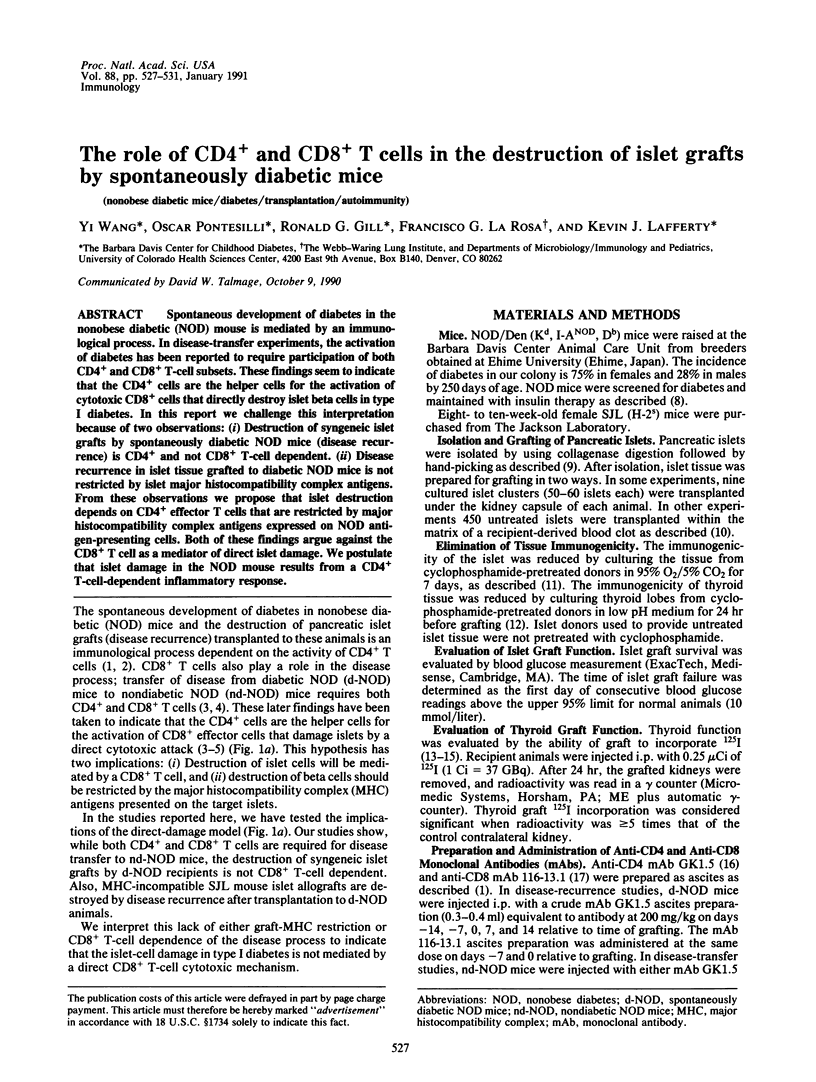
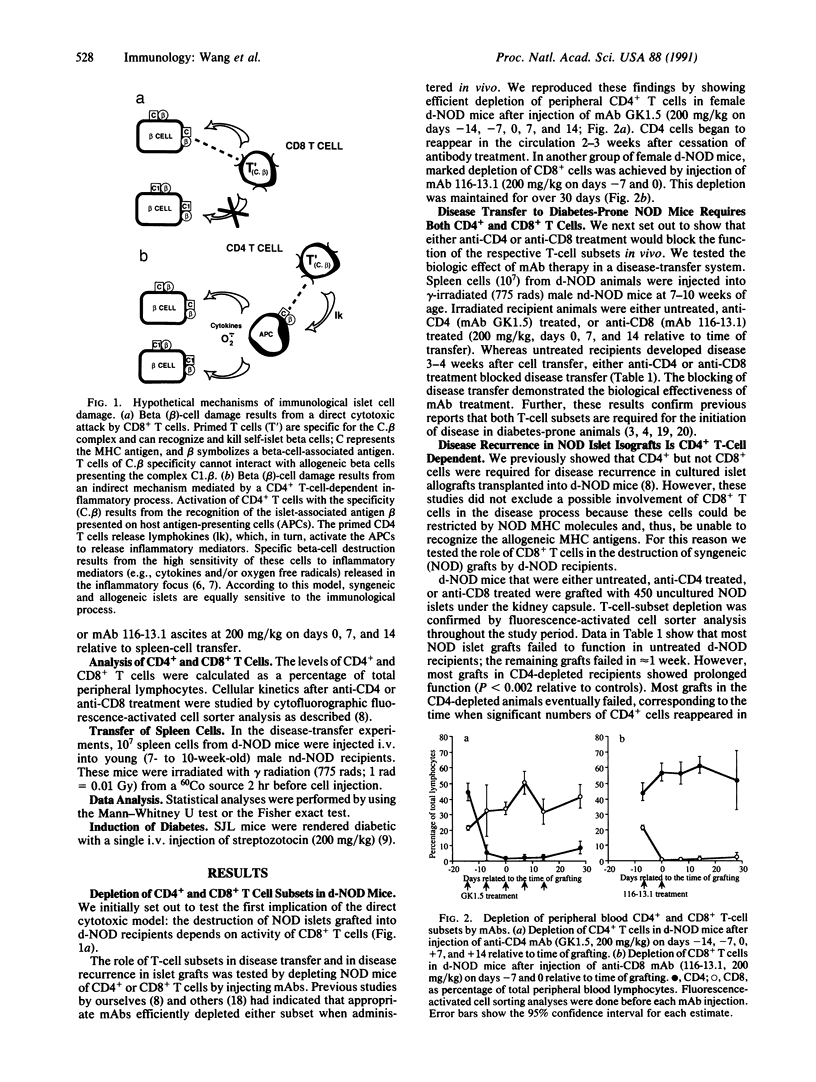
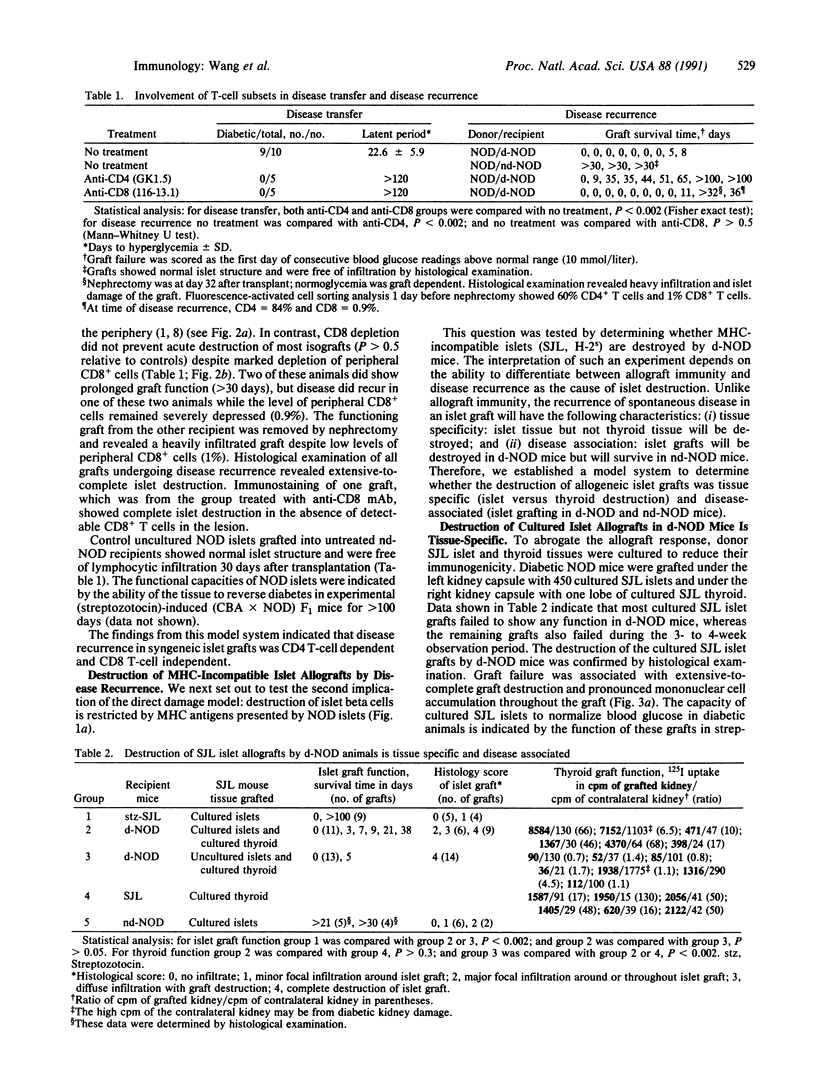
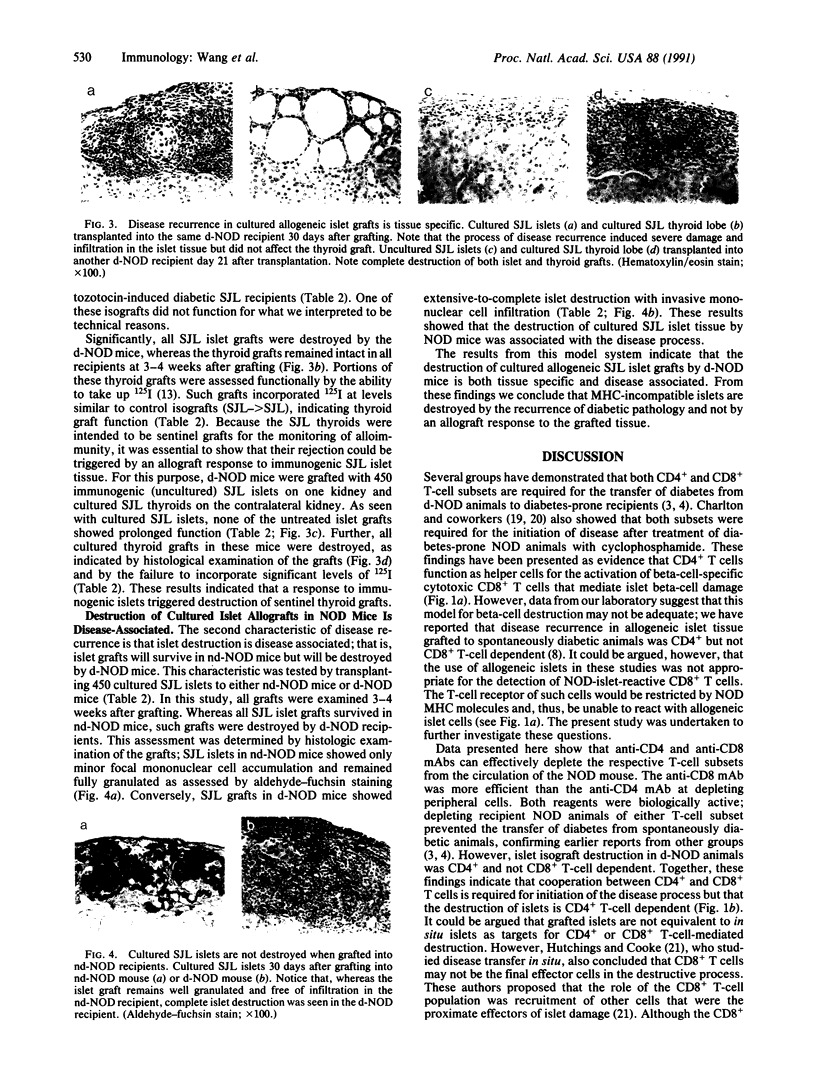
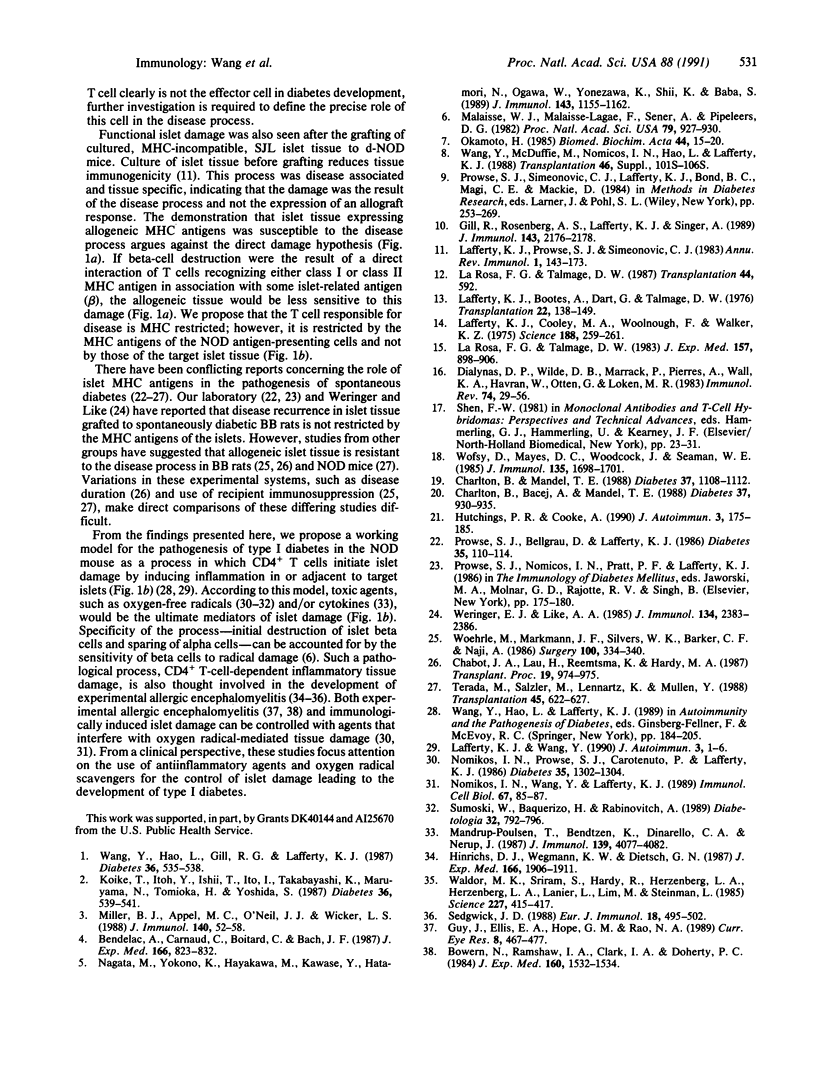
Images in this article
Selected References
These references are in PubMed. This may not be the complete list of references from this article.
- Bendelac A., Carnaud C., Boitard C., Bach J. F. Syngeneic transfer of autoimmune diabetes from diabetic NOD mice to healthy neonates. Requirement for both L3T4+ and Lyt-2+ T cells. J Exp Med. 1987 Oct 1;166(4):823–832. doi: 10.1084/jem.166.4.823. [DOI] [PMC free article] [PubMed] [Google Scholar]
- Bowern N., Ramshaw I. A., Clark I. A., Doherty P. C. Inhibition of autoimmune neuropathological process by treatment with an iron-chelating agent. J Exp Med. 1984 Nov 1;160(5):1532–1543. doi: 10.1084/jem.160.5.1532. [DOI] [PMC free article] [PubMed] [Google Scholar]
- Chabot J. A., Lau H., Reemtsma K., Hardy M. A. Successful islet transplantation in BB rats without chronic immunosuppression. Transplant Proc. 1987 Feb;19(1 Pt 2):974–975. [PubMed] [Google Scholar]
- Charlton B., Bacelj A., Mandel T. E. Administration of silica particles or anti-Lyt2 antibody prevents beta-cell destruction in NOD mice given cyclophosphamide. Diabetes. 1988 Jul;37(7):930–935. doi: 10.2337/diab.37.7.930. [DOI] [PubMed] [Google Scholar]
- Charlton B., Mandel T. E. Progression from insulitis to beta-cell destruction in NOD mouse requires L3T4+ T-lymphocytes. Diabetes. 1988 Aug;37(8):1108–1112. doi: 10.2337/diab.37.8.1108. [DOI] [PubMed] [Google Scholar]
- Dialynas D. P., Wilde D. B., Marrack P., Pierres A., Wall K. A., Havran W., Otten G., Loken M. R., Pierres M., Kappler J. Characterization of the murine antigenic determinant, designated L3T4a, recognized by monoclonal antibody GK1.5: expression of L3T4a by functional T cell clones appears to correlate primarily with class II MHC antigen-reactivity. Immunol Rev. 1983;74:29–56. doi: 10.1111/j.1600-065x.1983.tb01083.x. [DOI] [PubMed] [Google Scholar]
- Gill R. G., Rosenberg A. S., Lafferty K. J., Singer A. Characterization of primary T cell subsets mediating rejection of pancreatic islet grafts. J Immunol. 1989 Oct 1;143(7):2176–2178. [PubMed] [Google Scholar]
- Guy J., Ellis E. A., Hope G. M., Rao N. A. Antioxidant enzyme suppression of demyelination in experimental optic neuritis. Curr Eye Res. 1989 May;8(5):467–477. doi: 10.3109/02713688909000027. [DOI] [PubMed] [Google Scholar]
- Hinrichs D. J., Wegmann K. W., Dietsch G. N. Transfer of experimental allergic encephalomyelitis to bone marrow chimeras. Endothelial cells are not a restricting element. J Exp Med. 1987 Dec 1;166(6):1906–1911. doi: 10.1084/jem.166.6.1906. [DOI] [PMC free article] [PubMed] [Google Scholar]
- Hutchings P. R., Cooke A. The transfer of autoimmune diabetes in NOD mice can be inhibited or accelerated by distinct cell populations present in normal splenocytes taken from young males. J Autoimmun. 1990 Apr;3(2):175–185. doi: 10.1016/0896-8411(90)90139-j. [DOI] [PubMed] [Google Scholar]
- Koike T., Itoh Y., Ishii T., Ito I., Takabayashi K., Maruyama N., Tomioka H., Yoshida S. Preventive effect of monoclonal anti-L3T4 antibody on development of diabetes in NOD mice. Diabetes. 1987 Apr;36(4):539–541. doi: 10.2337/diab.36.4.539. [DOI] [PubMed] [Google Scholar]
- La Rosa F. G., Talmage D. W. The abrogation of thyroid allograft rejection by culture in acid medium. Transplantation. 1987 Oct;44(4):592–592. doi: 10.1097/00007890-198710000-00032. [DOI] [PubMed] [Google Scholar]
- La Rosa F. G., Talmage D. W. The failure of a major histocompatibility antigen to stimulate a thyroid allograft reaction after culture in oxygen. J Exp Med. 1983 Mar 1;157(3):898–906. doi: 10.1084/jem.157.3.898. [DOI] [PMC free article] [PubMed] [Google Scholar]
- Lafferty K. J., Bootes A., Dart G., Talmage D. W. Effect of organ culture on the survival of thyroid allografts in mice. Transplantation. 1976 Aug;22(2):138–149. doi: 10.1097/00007890-197608000-00009. [DOI] [PubMed] [Google Scholar]
- Lafferty K. J., Cooley M. A., Woolnough J., Walker K. Z. Thyroid allograft immunogenicity is reduced after a period in organ culture. Science. 1975 Apr 18;188(4185):259–261. doi: 10.1126/science.1118726. [DOI] [PubMed] [Google Scholar]
- Lafferty K. J., Prowse S. J., Simeonovic C. J., Warren H. S. Immunobiology of tissue transplantation: a return to the passenger leukocyte concept. Annu Rev Immunol. 1983;1:143–173. doi: 10.1146/annurev.iy.01.040183.001043. [DOI] [PubMed] [Google Scholar]
- Malaisse W. J., Malaisse-Lagae F., Sener A., Pipeleers D. G. Determinants of the selective toxicity of alloxan to the pancreatic B cell. Proc Natl Acad Sci U S A. 1982 Feb;79(3):927–930. doi: 10.1073/pnas.79.3.927. [DOI] [PMC free article] [PubMed] [Google Scholar]
- Mandrup-Poulsen T., Bendtzen K., Dinarello C. A., Nerup J. Human tumor necrosis factor potentiates human interleukin 1-mediated rat pancreatic beta-cell cytotoxicity. J Immunol. 1987 Dec 15;139(12):4077–4082. [PubMed] [Google Scholar]
- Miller B. J., Appel M. C., O'Neil J. J., Wicker L. S. Both the Lyt-2+ and L3T4+ T cell subsets are required for the transfer of diabetes in nonobese diabetic mice. J Immunol. 1988 Jan 1;140(1):52–58. [PubMed] [Google Scholar]
- Nagata M., Yokono K., Hayakawa M., Kawase Y., Hatamori N., Ogawa W., Yonezawa K., Shii K., Baba S. Destruction of pancreatic islet cells by cytotoxic T lymphocytes in nonobese diabetic mice. J Immunol. 1989 Aug 15;143(4):1155–1162. [PubMed] [Google Scholar]
- Nomikos I. N., Prowse S. J., Carotenuto P., Lafferty K. J. Combined treatment with nicotinamide and desferrioxamine prevents islet allograft destruction in NOD mice. Diabetes. 1986 Nov;35(11):1302–1304. doi: 10.2337/diab.35.11.1302. [DOI] [PubMed] [Google Scholar]
- Nomikos I. N., Wang Y., Lafferty K. J. Involvement of O2 radicals in 'autoimmune' diabetes. Immunol Cell Biol. 1989 Feb;67(Pt 1):85–87. doi: 10.1038/icb.1989.12. [DOI] [PubMed] [Google Scholar]
- Okamoto H. The role of poly(ADP-ribose) synthetase in the development of insulin-dependent diabetes and islet B-cell regeneration. Biomed Biochim Acta. 1985;44(1):15–20. [PubMed] [Google Scholar]
- Prowse S. J., Bellgrau D., Lafferty K. J. Islet allografts are destroyed by disease occurrence in the spontaneously diabetic BB rat. Diabetes. 1986 Jan;35(1):110–114. doi: 10.2337/diab.35.1.110. [DOI] [PubMed] [Google Scholar]
- Sedgwick J. D. Long-term depletion of CD8+ T cells in vivo in the rat: no observed role for CD8+ (cytotoxic/suppressor) cells in the immunoregulation of experimental allergic encephalomyelitis. Eur J Immunol. 1988 Apr;18(4):495–502. doi: 10.1002/eji.1830180402. [DOI] [PubMed] [Google Scholar]
- Sumoski W., Baquerizo H., Rabinovitch A. Oxygen free radical scavengers protect rat islet cells from damage by cytokines. Diabetologia. 1989 Nov;32(11):792–796. doi: 10.1007/BF00264909. [DOI] [PubMed] [Google Scholar]
- Terada M., Salzler M., Lennartz K., Mullen Y. The effect of H-2 compatibility on pancreatic beta cell survival in the nonobese diabetic mouse. Transplantation. 1988 Mar;45(3):622–627. doi: 10.1097/00007890-198803000-00024. [DOI] [PubMed] [Google Scholar]
- Waldor M. K., Sriram S., Hardy R., Herzenberg L. A., Herzenberg L. A., Lanier L., Lim M., Steinman L. Reversal of experimental allergic encephalomyelitis with monoclonal antibody to a T-cell subset marker. Science. 1985 Jan 25;227(4685):415–417. doi: 10.1126/science.3155574. [DOI] [PubMed] [Google Scholar]
- Wang Y., Hao L., Gill R. G., Lafferty K. J. Autoimmune diabetes in NOD mouse is L3T4 T-lymphocyte dependent. Diabetes. 1987 Apr;36(4):535–538. doi: 10.2337/diab.36.4.535. [DOI] [PubMed] [Google Scholar]
- Wang Y., McDuffie M., Nomikos I. N., Hao L., Lafferty K. J. Effect of cyclosporine on immunologically mediated diabetes in nonobese diabetic mice. Transplantation. 1988 Aug;46(2 Suppl):101S–106S. doi: 10.1097/00007890-198808001-00019. [DOI] [PubMed] [Google Scholar]
- Weringer E. J., Like A. A. Immune attack on pancreatic islet transplants in the spontaneously diabetic BioBreeding/Worcester (BB/W) rat is not MHC restricted. J Immunol. 1985 Apr;134(4):2383–2386. [PubMed] [Google Scholar]
- Woehrle M., Markmann J. F., Silvers W. K., Barker C. F., Naji A. Transplantation of cultured pancreatic islets to BB rats. Surgery. 1986 Aug;100(2):334–341. [PubMed] [Google Scholar]
- Wofsy D., Mayes D. C., Woodcock J., Seaman W. E. Inhibition of humoral immunity in vivo by monoclonal antibody to L3T4: studies with soluble antigens in intact mice. J Immunol. 1985 Sep;135(3):1698–1701. [PubMed] [Google Scholar]








